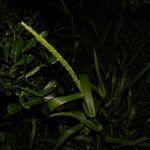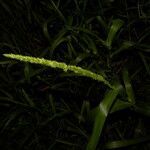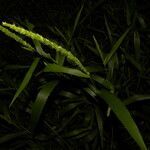Coarse aquatic perennial; culms succulent, slender or usually rather thick, sparingly branching, glabrous, the base creeping, rooting at the nodes, 1-2 m. long, or even longer; sheaths usually shorter than the internodes, glabrous or sometimes ciliate on the margins; blades commonly 15-35 cm. long, 1.5-3 cm. wide, or smaller on some of the branches, acuminate, gradually narrowed from the cordate-clasping base, the margins scabrous, more or less papillose-hispid-ciliate at the base; panicles 20-50 cm. long, sometimes shorter, 8-15 mm. thick, dense, spike-like, the lower branches often distant; spikelets 3-4 mm. long, acuminate, the second glume and sterile lemma rather prominently scabrous on the nerves, the lemma often awn-pointed.



